Experimental and Numerical Analyses of Temperature-Reducing-Effect by Heat of Water Evaporation on a Moss-Greening Ceramic Utilizing Waste Silica
Abstract
:1. Introduction
- (1)
- Rooftop greening is subject to weight limitations.
- (2)
- Installing greening plants on rooftops is expensive.
- (3)
- It is necessary to protect rooftops from corrosion or deterioration caused by greening plants.
- (4)
- Greening-plant maintenance is labor-intensive.
2. Materials and Methods
2.1. Materials
2.1.1. Production of the Moss-Covered Ceramic
2.1.2. Physical Properties of the Ceramics
2.2. Experimental Methods
2.2.1. Laboratory Experiment
2.2.2. Field Experiment
2.3. Methods of FEM Analyses
2.3.1. Overview of the FEM Analyses
2.3.2. FEM Model and Computational Conditions
- (1)
- The water evaporation heat per mass was 2452–2380 kJ·kg−1 (20–50 °C), as in Reference [36].
- (2)
- The quantity of heat did not change significantly in this temperature range. Therefore, the heat of evaporation per unit mass was approximated to a constant value of 2400 kJ·kg−1. The heat of water evaporation per unit time, was estimated by multiplying the rate of water evaporation for each sample by the heat of water evaporation per unit mass.
- (3)
- The heat flux Q3 was approximated by dividing the heat of water evaporation per unit time absorbed from each sample, by the sample surface areas of AB, BC, and FA.
3. Results and Discussions
3.1. Laboratory Experiment
3.1.1. Experimental Results
- (1)
- While the moss-covered sample contained sufficient water, or water was evaporating from the sample, the surface-temperature of the sample was lower than that of the mortar sample.
- (2)
- The surface-temperature of the moss-covered sample that contained slight amounts of water, went up to nearly the temperature of the mortar sample that contained slight amounts of water. The difference in their final temperatures was only 2~3 °C.
- (3)
- The above results confirmed that the moss-covered sample does not exhibit much temperature-reducing ability, when the sample does not contain sufficient water, and that water included in the sample significantly affects the temperature reduction. This leads to the conclusion that, it is desirable to use the moss-covered sample in a sufficient water-absorbing state.
3.1.2. The Results of FEM Analyses
3.2. Field Experiment
3.2.1. Results of Field Experiments
3.2.2. FEM Analyses on the Field Experiments
4. Conclusions
Author Contributions
Funding
Conflicts of Interest
References
- Ministry of the Environment in Japan. Annual Report on the Environment, the Sound Material-Cycle Society and Biodiversity in Japan; Ministry of the Environment: Tokyo, Japan, 2016; Volume 2016, pp. 1–36.
- Tokyo Metropolitan Government: Bureau of Environment, Other Issues, Heat Island Effects. Available online: https://www.kankyo.metro.tokyo.jp/en/other_issues/heat_island.html (accessed on 14 August 2018).
- Cabinet Office, Government of Japan, Japanese Economy 2011–2012, Section 3 of Chapter 1. Available online: http://www5.cao.go.jp/keizai3/2011/1221nk/nk11.html (accessed on 14 August 2018).
- Yamagata, H.; Nasu, M.; Yoshizawa, M.; Miyamoto, A.; Minamiyama, M. Heat island mitigation using water retentive pavement sprinkled with reclaimed wastewater. Water Sci. Technol. 2008, 57, 763–771. [Google Scholar] [CrossRef] [PubMed]
- Kim, R.H.; Park, J.B.; Mun, J.S.; Lee, J.H. Reduction Effects of Urban Heat Island by Water-Retentive Pavement. Mater. Sci. Forum 2012, 724, 147–150. [Google Scholar] [CrossRef]
- Hendel, M.A.; Colombert, M.; Diab, Y.; Royon, L. Measurement of the Cooling Efficiency of Pavement-watering as an Urban Heat Island Mitigation Technique. J. Sustain. Dev. Energy Water Environ. Syst. 2015, 3, 1–11. [Google Scholar] [CrossRef]
- Santamouris, M. Cooling the cities—A review of reflective and green roof mitigation technologies to fight heat island and improve comfort in urban environments. Sol. Energy 2014, 103, 682–703. [Google Scholar] [CrossRef]
- Yasuda, Y.; Kinoshita, H.; Yasui, K.; Yuji, T.; Okamura, Y.; Sezaki, M.; Kawamura, R. Ceramics utilizing glass fiber-reinforced plastic as civil engineering materials to counteract the heat island phenomenon. Mech. Eng. J. 2016, 3. [Google Scholar] [CrossRef]
- Kristin, L.; Getter, D. Bradley, Rowe: The Role of Extensive Green Roofs in Sustainable Development. Hortscience 2006, 41, 1276–1285. [Google Scholar]
- Kinoshita, H.; Kaizu, K.; Yasuda, Y.; Nakazono, T.; Kobayashi, T.; Fukuyama, H.; Kawamura, R.; Ikeda, K.; Kawasaki, H. Development of Greening Plant Consists of Moss and Porous Ceramic Base Material of High Strength Made by Recycling Waste GFRP. J. Jpn. Soc. Exp. Mech. 2013, 13, 100–106. [Google Scholar] [CrossRef]
- Ooka, R. The effect of wall roof greening of a building. Jpn. Soc. Fluid Mech. 2005, 24, 497–503. [Google Scholar]
- Minemura, D.; Yamada, H.; Yamamoto, M.; Nakao, S.; Nakajima, A.; Yabushi, N. Practical study on the reduction effect of the heat absorption of the building by the roof top Plantings. Environ. Syst. Res. 2002, 30, 277–283. [Google Scholar] [CrossRef]
- Yokoyama, H.; Ueno, T.; Yoshioka, M.; Narita, K. Thermal Properties of Light and Thin Rooftop Moss-Greening, Annual Report on Tokyo Metropolitan Government; Tokyo Metropolitan Government: Tokyo, Japan, 2012; pp. 180–183. [Google Scholar]
- Fujii, Y.; Yamada, H. Comparison for the heat budget of roof greening systems. In 38th Proceedings on Environmental Systems in the Japan Society of Civil Engineers; Japan Society of Civil Engineers: Tokyo, Japan, 2010; pp. 277–281. [Google Scholar]
- Tada, Y.; Tashiro, T.; Tsuboi, S. Thermal environment improvement by using Kudzu in rooftop gardening. J. Heat Isl. Inst. Int. 2013, 8, 1–6. (In Japanese) [Google Scholar]
- Suzuki, H. Review of the former researches on the improvement effects of thermal environment by the building greening. J. Jpn. Soc. Reveg. Technol. 2008, 34, 355–362. [Google Scholar] [CrossRef]
- Yamada, H. An improvement of city environment by the building greening, and future view. J. Jpn. Soc. Reveg. Technol. 2008, 34, 333–337. [Google Scholar] [CrossRef]
- Fujita, S. Isuue of rooftop greening. J. Jpn. Soc. Reveg. Technol. 2009, 34, 344–349. [Google Scholar] [CrossRef]
- Saadatian, O.; Sopian, K.; Salleh, E.; Lim, C.H.; Riffat, S.; Saadatian, E.; Toudeshki, A.; Sulaiman, M.Y. A review of energy aspects of green roofs. Renew. Sustain. Energy Rev. 2013, 23, 155–168. [Google Scholar] [CrossRef]
- Berardi, U.; GhaffarianHoseini, A.; GhaffarianHoseini, A. State-of-the-art analysis of the environmental benefits of green roofs. Appl. Energy 2014, 115, 411–428. [Google Scholar] [CrossRef]
- Parizotto, S.; Lamberts, R. Investigation of green roof thermal performance in temperate climate: A case study of an experimental building in Florianópolis city, Southern Brazil. Energy Build. 2011, 43, 1712–1722. [Google Scholar] [CrossRef]
- Ghaffarianhoseini, A.; Dahlan, N.D.; Berardi, U.; Ghaffarianhoseini, A.; Makaremi, N.; Ghaffarianhoseini, M. Sustainable energy performances of green buildings: A review of current theories, implementations and challenges. Renew. Sustain. Energy Rev. 2013, 25, 1–17. [Google Scholar] [CrossRef]
- Usukura, T.; Kajiya, R.; Kubo, R.; Fujiwara, Y. Study on thermal characteristics of roof-top moss-planting: (Part2) Study on thermal analysis based on measurement experiment data. In Proceedings of the Society of Heating, Air-Conditioning Sanitary Engineers of Japan; Air-Conditioning Sanitary Engineers of Japan: Tokyo, Japan, 2005; pp. 433–436. (In Japanese) [Google Scholar]
- Hashida, S.; Ma, R.R.; Kajiya, R.; Sakai, K. Measurement research on influence that moss-covered exerts on thermal environment. In 2008 Proceedings of the Society of Heating, Air-Conditioning and Sanitary Engineers of Japan; Air-Conditioning and Sanitary Engineers of Japan: Tokyo, Japan, 2008; pp. 2219–2222. (In Japanese) [Google Scholar]
- Wang, Y.; Ma, C.; Liu, Y.; Wang, D.; Liu, J. Effect of moisture migration and phase change on effective thermal conductivity of porous building materials. Int. J. Heat Mass Transf. 2018, 125, 330–342. [Google Scholar] [CrossRef]
- Zhang, L.; Pan, Z.; Zhang, Y.; Meng, Q. Impact of climatic factors on evaporative cooling of porous building materials. Energy Build. 2018, 173, 601–612. [Google Scholar] [CrossRef]
- Karamanis, D. Application of zeolitic materials prepared from fly ash to water vapor adsorption for solar cooling. Appl. Energy 2012, 97, 334–339. [Google Scholar] [CrossRef]
- Karamanis, D.; Vardoulakis, E.; Kyritsi, E.; Ökte, N. Surface solar cooling through water vapor desorption from photo-responsive sepiolite nanocomposites. Energy Convers. Manag. 2012, 63, 118–122. [Google Scholar] [CrossRef]
- He, J. Experimental study of cooling effects of a passive evaporative cooling wall constructed of porous ceramics with high water soaking-up ability. Build. Environ. 2010, 45, 461–472. [Google Scholar] [CrossRef]
- Coutts, A.M.; Daly, E.; Beringer, J.; Tapper, N.J. Assessing practical measures to reduce urban heat: Green and cool roofs. Build. Environ. 2013, 70, 266–276. [Google Scholar] [CrossRef]
- Santamouris, M. Using cool pavements as a mitigation strategy to fight urban heat island—A review of the actual developments. Renew. Sustain. Energy Rev. 2013, 26, 224–240. [Google Scholar] [CrossRef]
- Qin, Y.; Hiller, J.E. Understanding pavement-surface energy balance and its implications on cool pavement development. Energy Build. 2014, 85, 389–399. [Google Scholar] [CrossRef]
- Qin, Y.; Hiller, J.E. Water availability near the surface dominates the evaporation of pervious concrete. Constr. Build. Mater. 2016, 111, 77–84. [Google Scholar] [CrossRef]
- Berardi, U.; La Roche, P.; Almodovar, J.M. Water-to-air-heat exchanger and indirect evaporative cooling in buildings with green roofs. Energy Build. 2017, 151, 406–417. [Google Scholar] [CrossRef]
- Tanaka, M. Clay Roof Tiles Handbook; Gihodo Shuppan: Tokyo, Japan, 1980; pp. 22–23. (In Japanese) [Google Scholar]
- The Japan Society of Mechanical Engineering. JSME Heat Transfer Handbook; The Japan Society of Mechanical Engineering: Tokyo, Japan, 1993; pp. 375–376. (In Japanese) [Google Scholar]
- DowKakoh, Catalog. 2017. Available online: https://www.dowkakoh.co.jp/catalog.html (accessed on 14 August 2018).
- Nishikawa, K.; Fujita, Y. Heat Transfer 1982; Rikogakusha Publishing: Tokyo, Japan, 1982; p. 303. [Google Scholar]
- Hisatake, K.; Tanaka, S.; Aizawa, Y. Evaporation rate of water in a vessel. J. Appl. Phys. 1993, 73, 7395–7401. [Google Scholar] [CrossRef]
- Ueda, M.; Shiba, K. The effect of natural convection on the rate of evaporation of water. Jpn. Soc. Appl. Phys. 1964, 33, 269–273. [Google Scholar] [CrossRef]
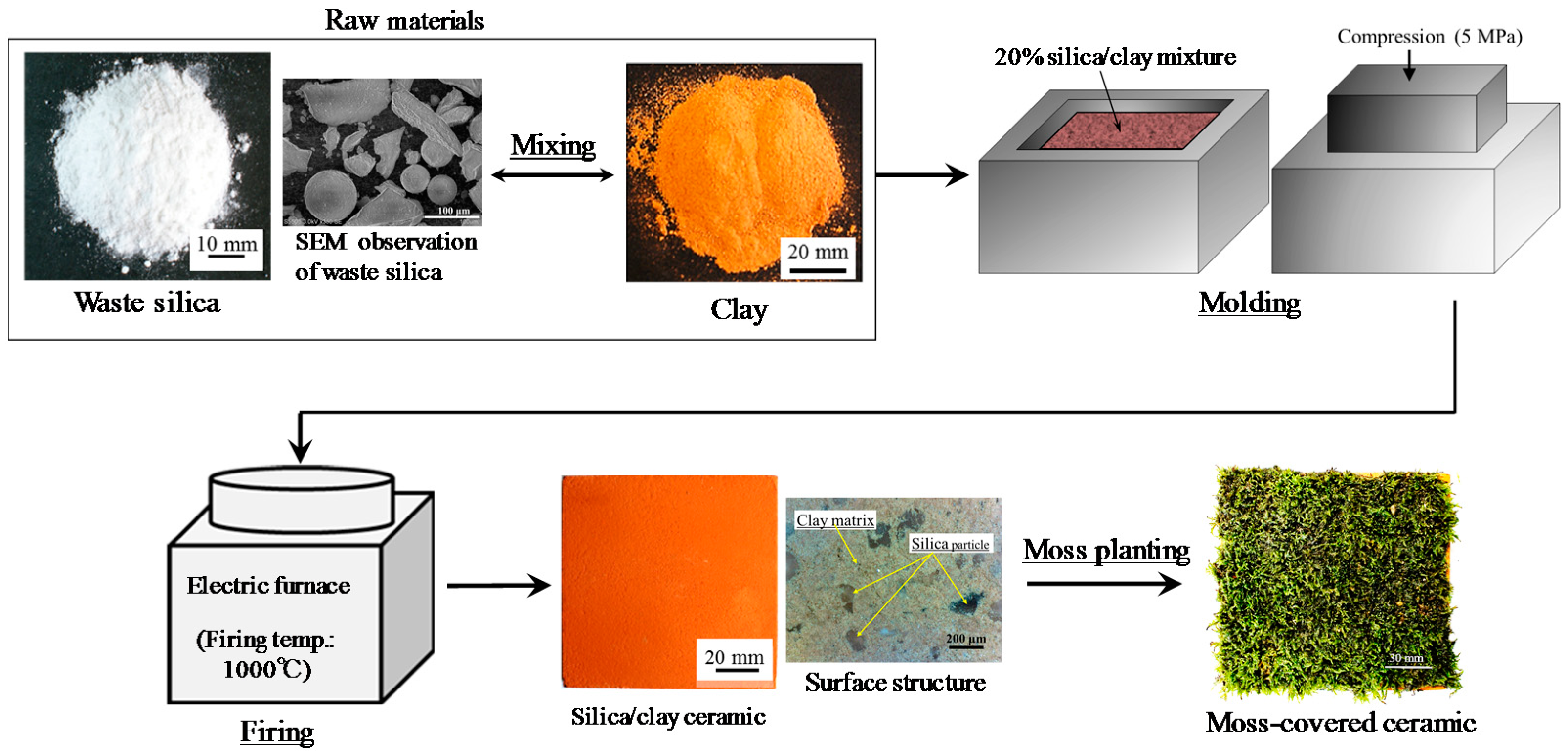
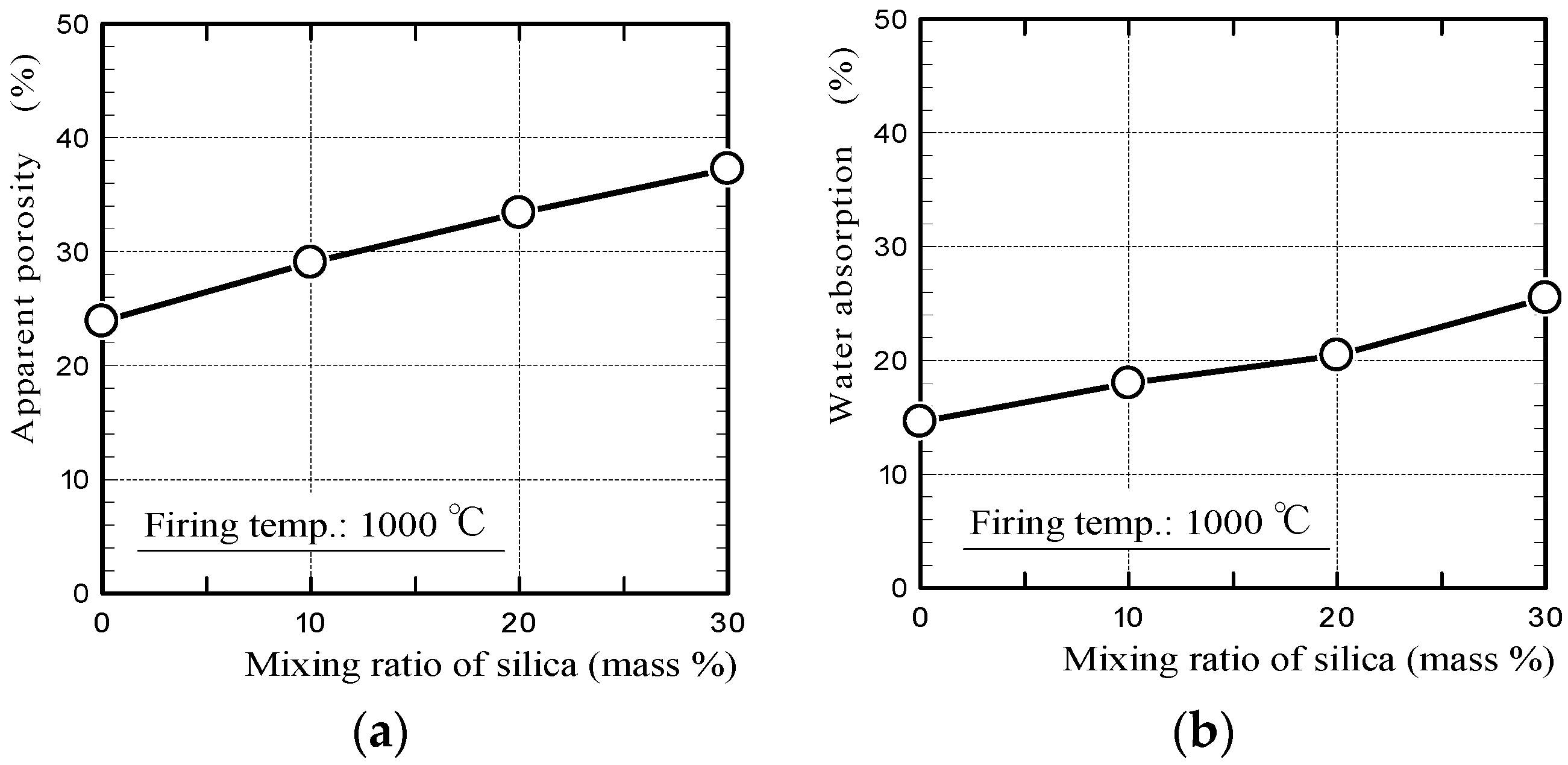
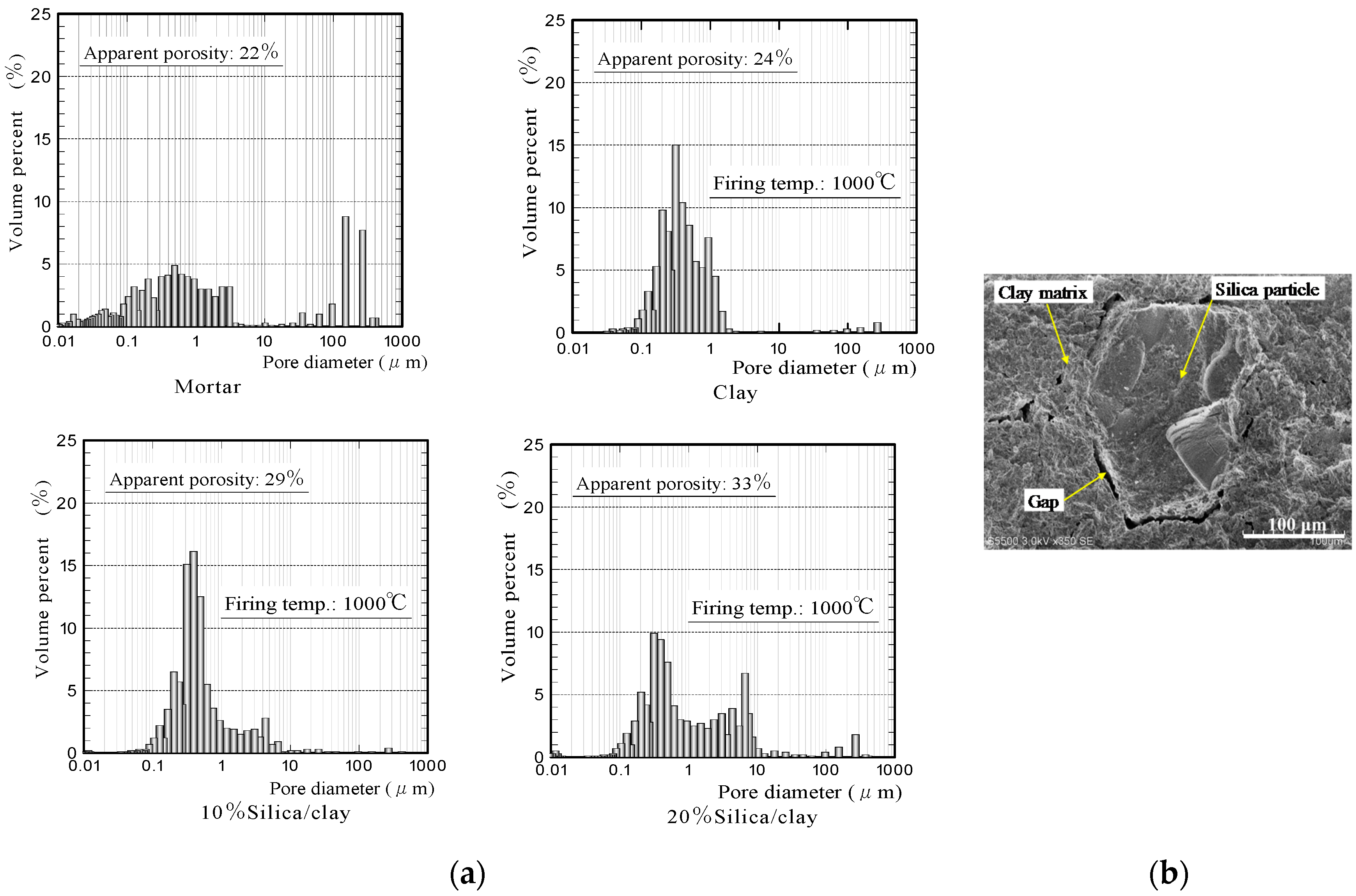
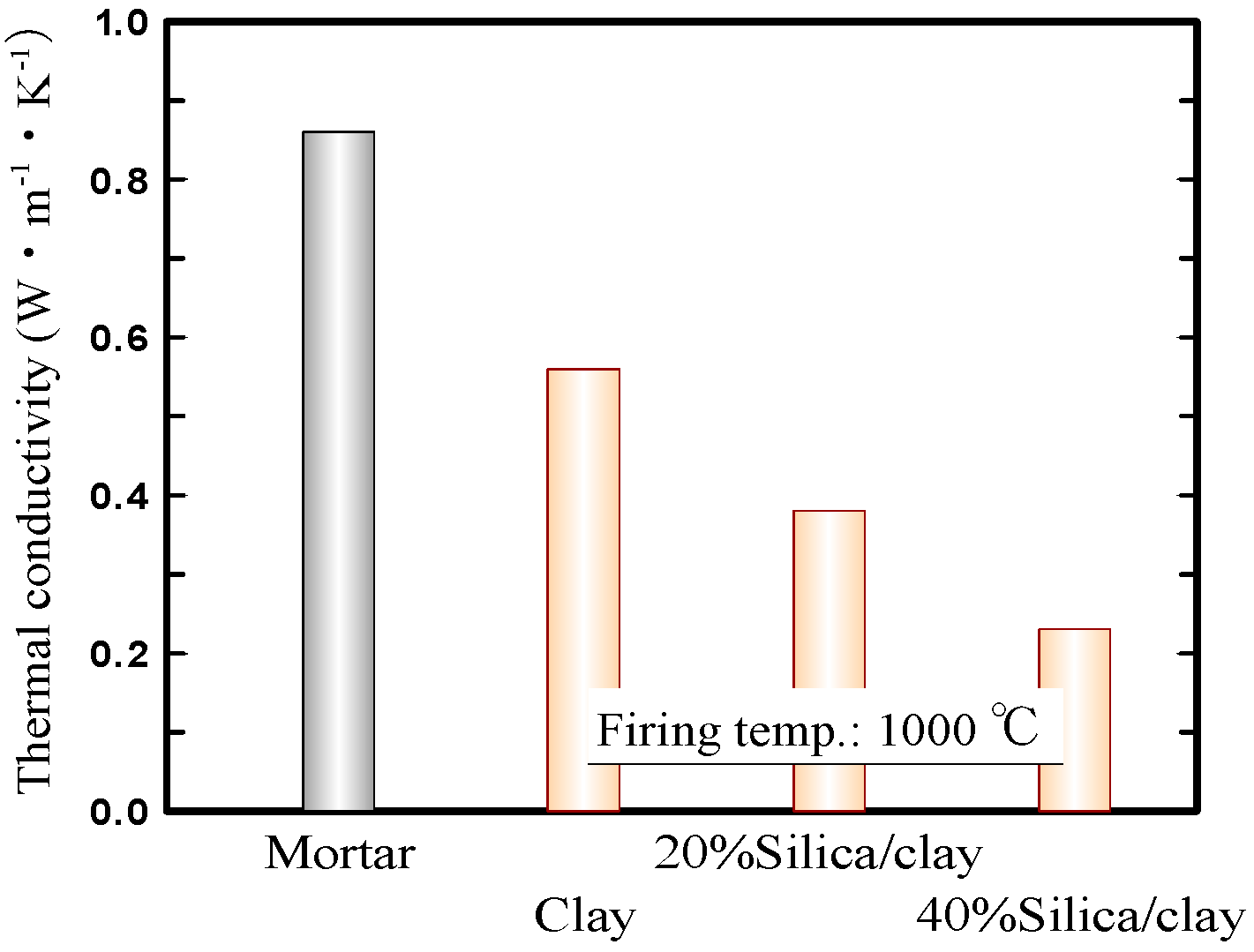
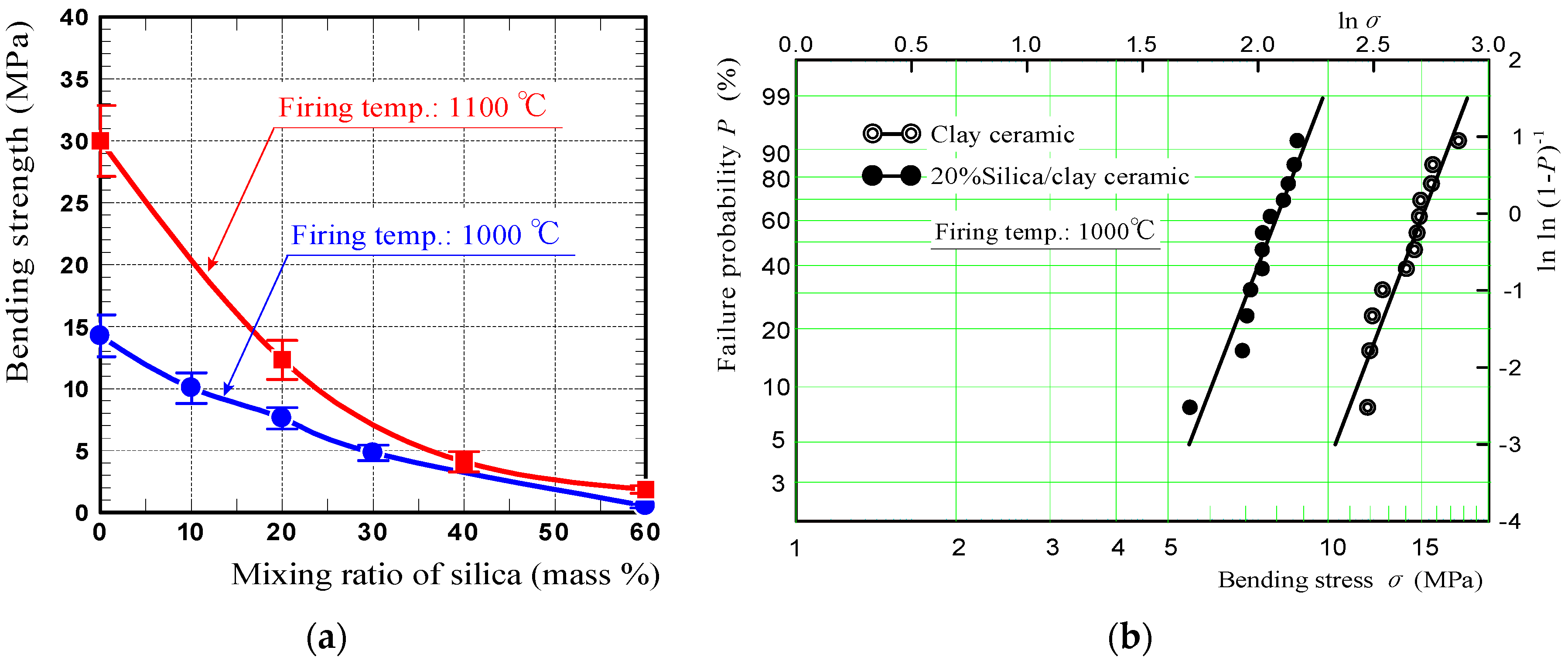
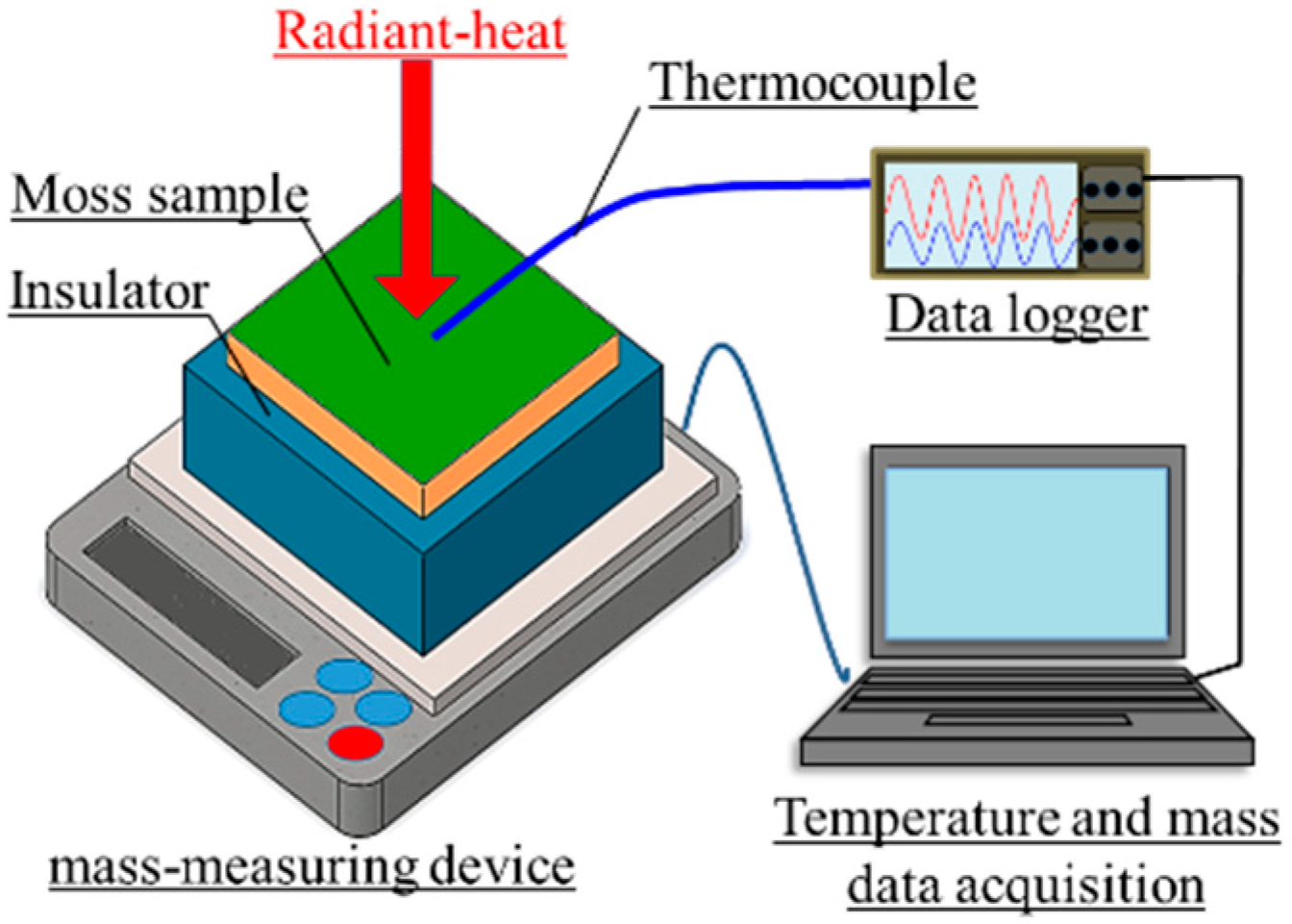
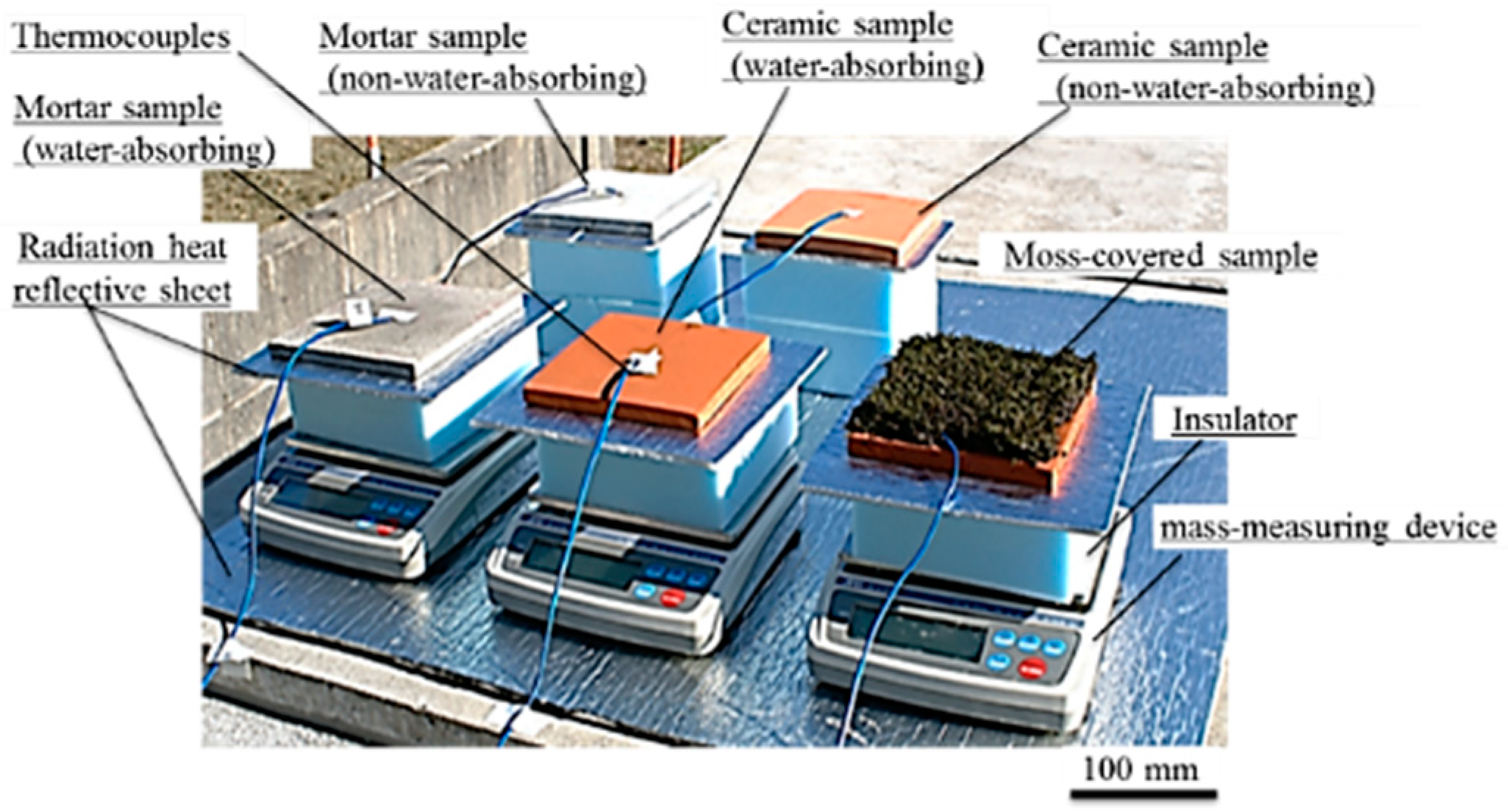

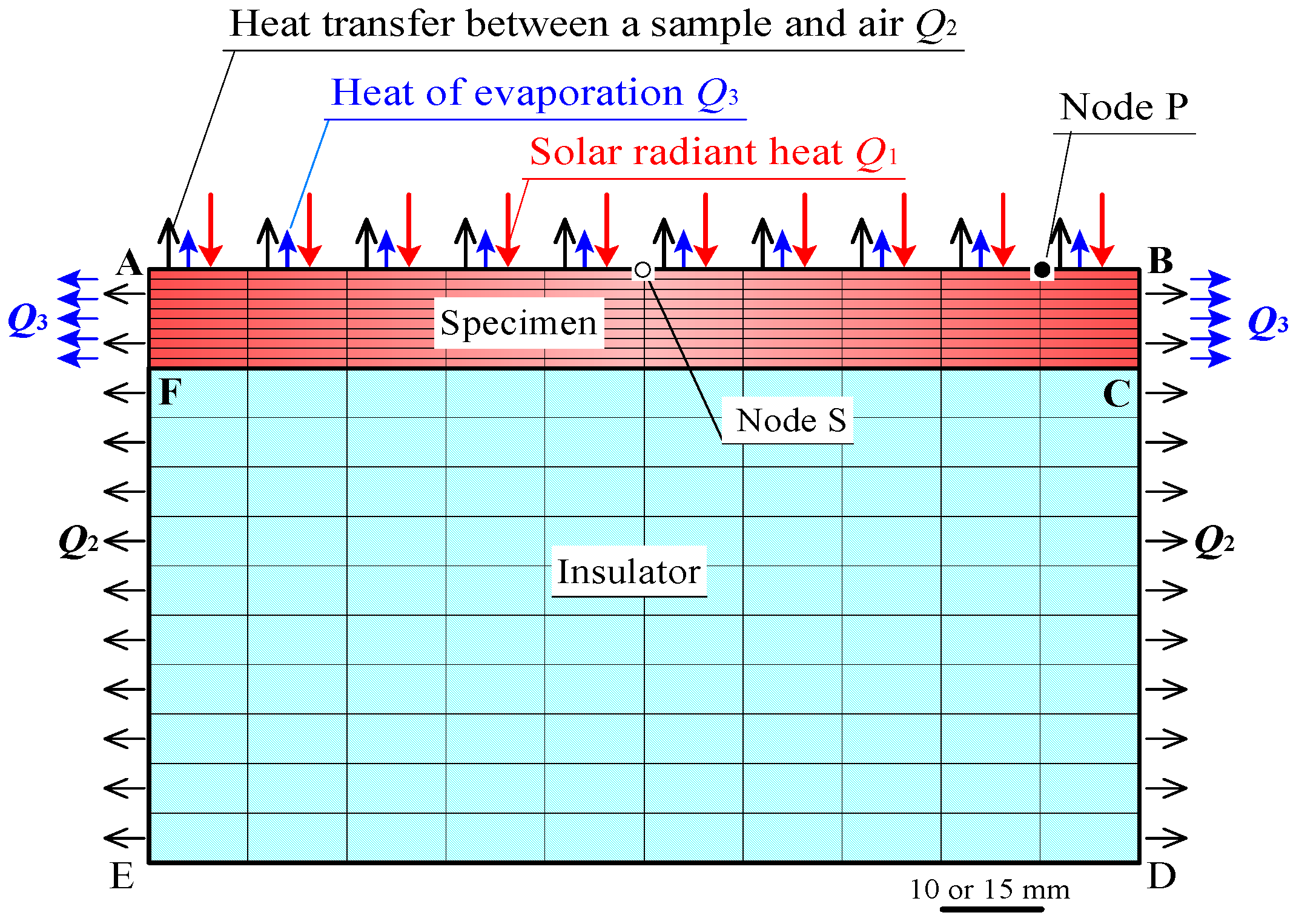
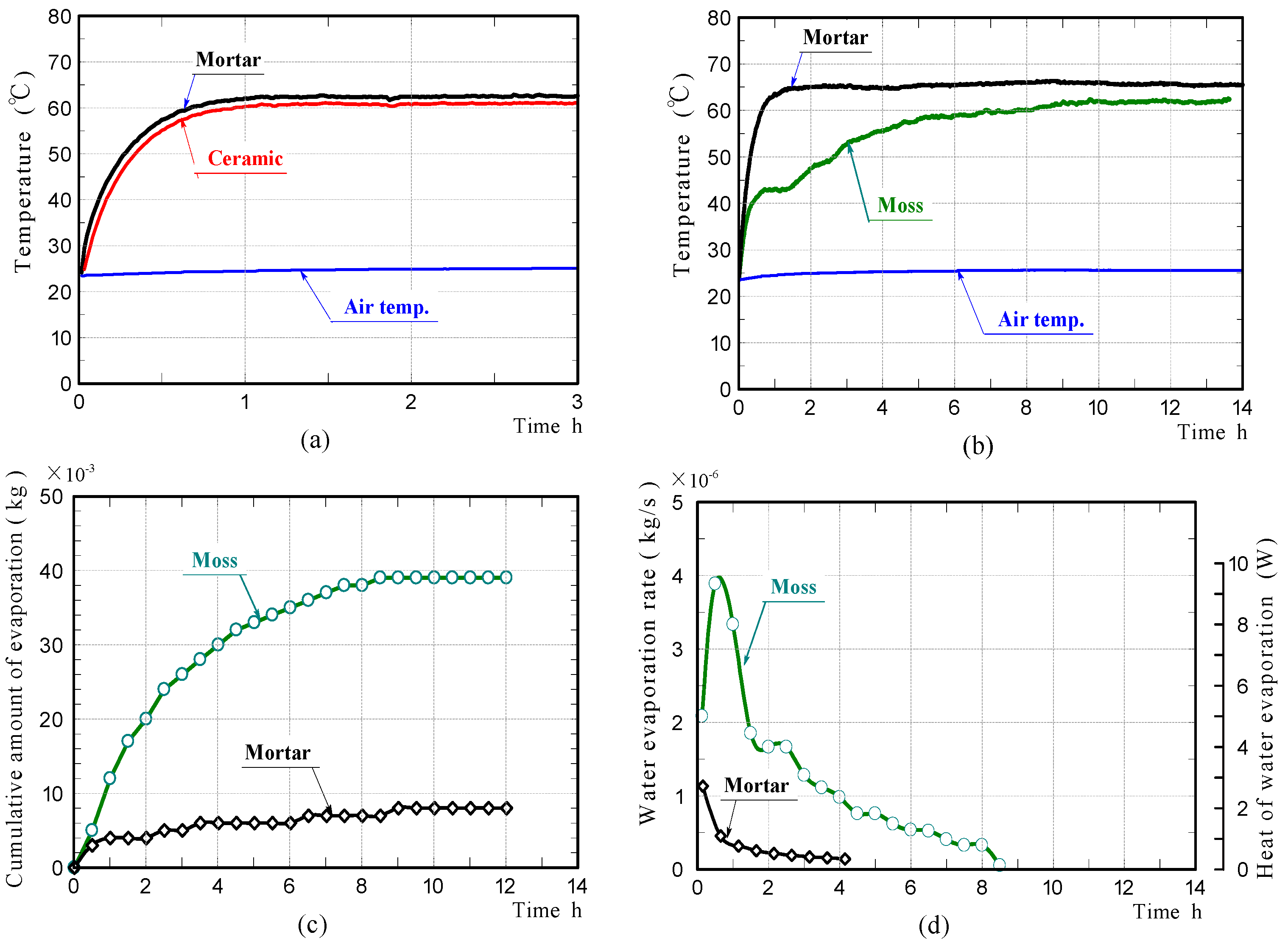


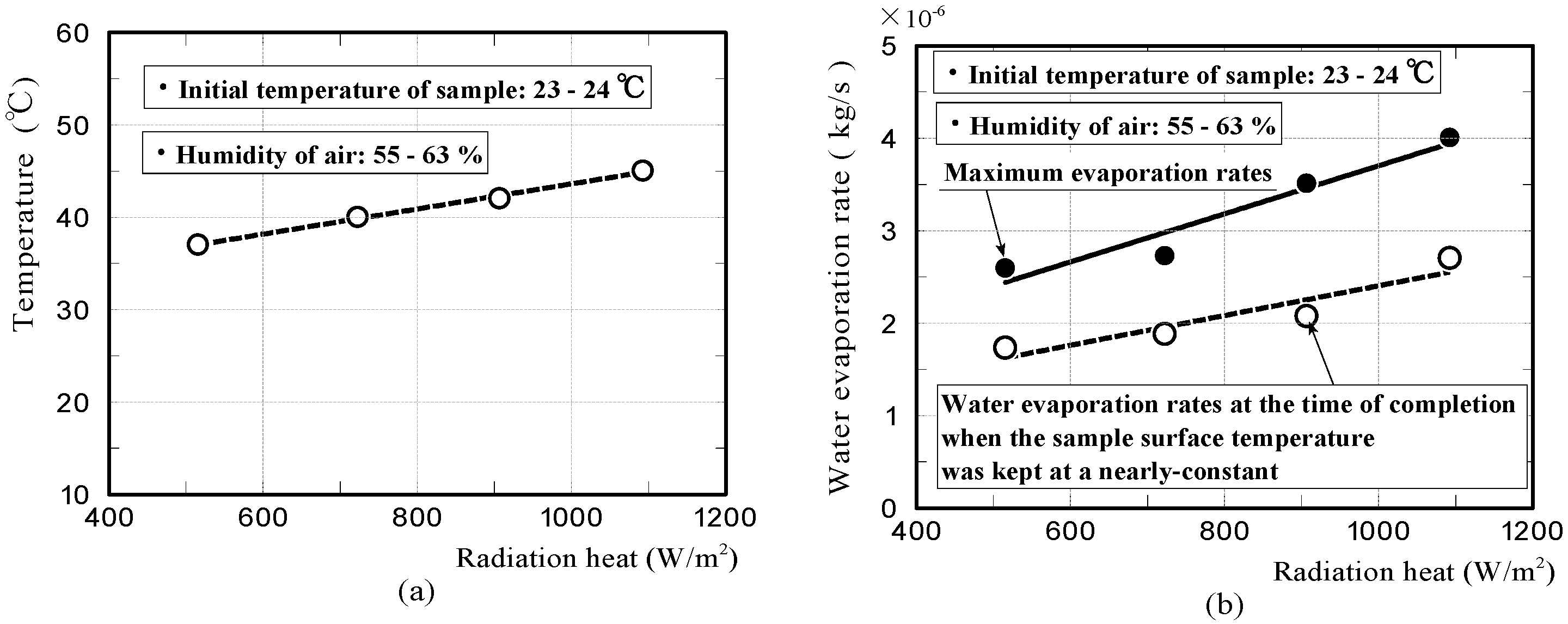
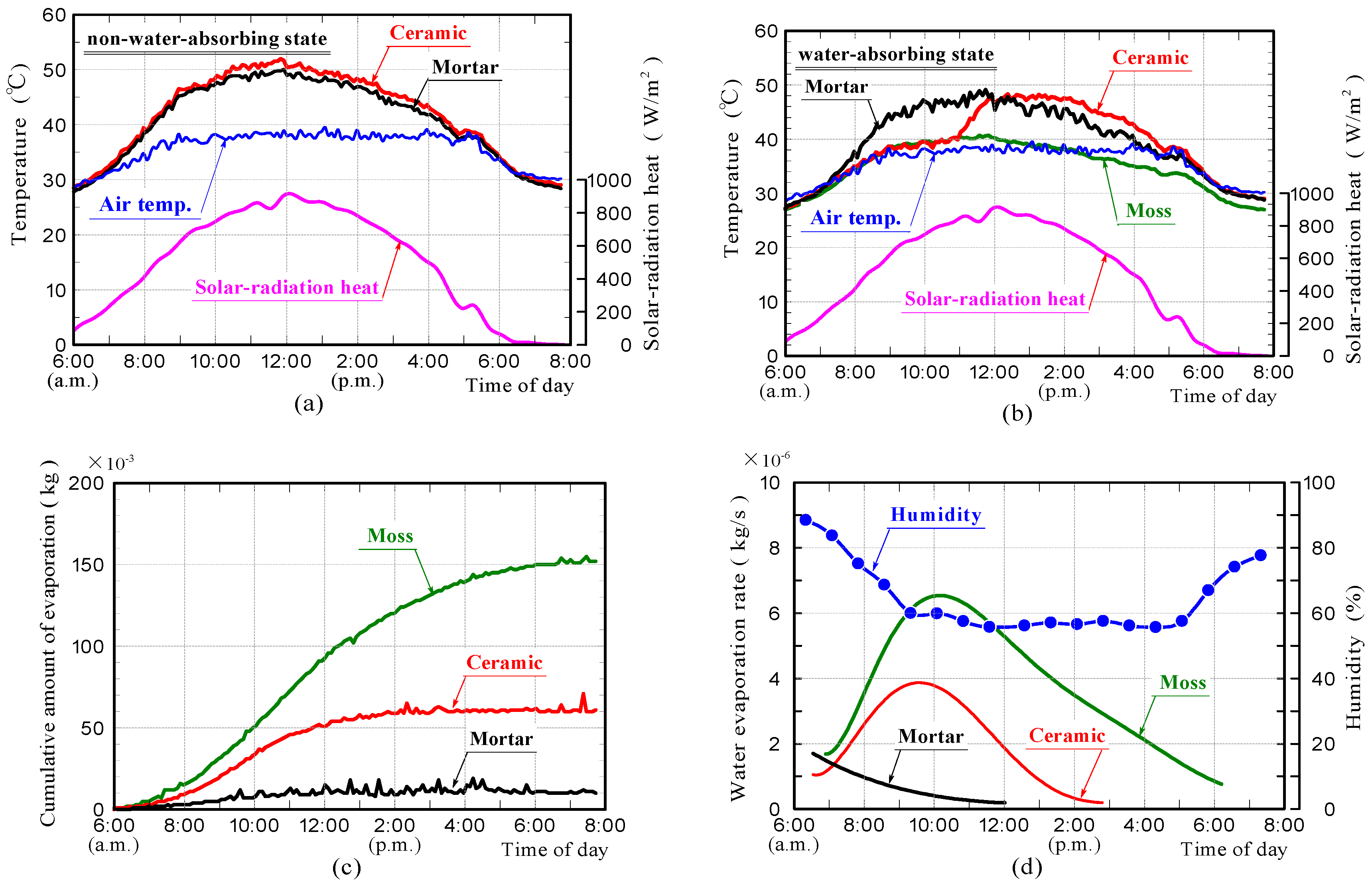
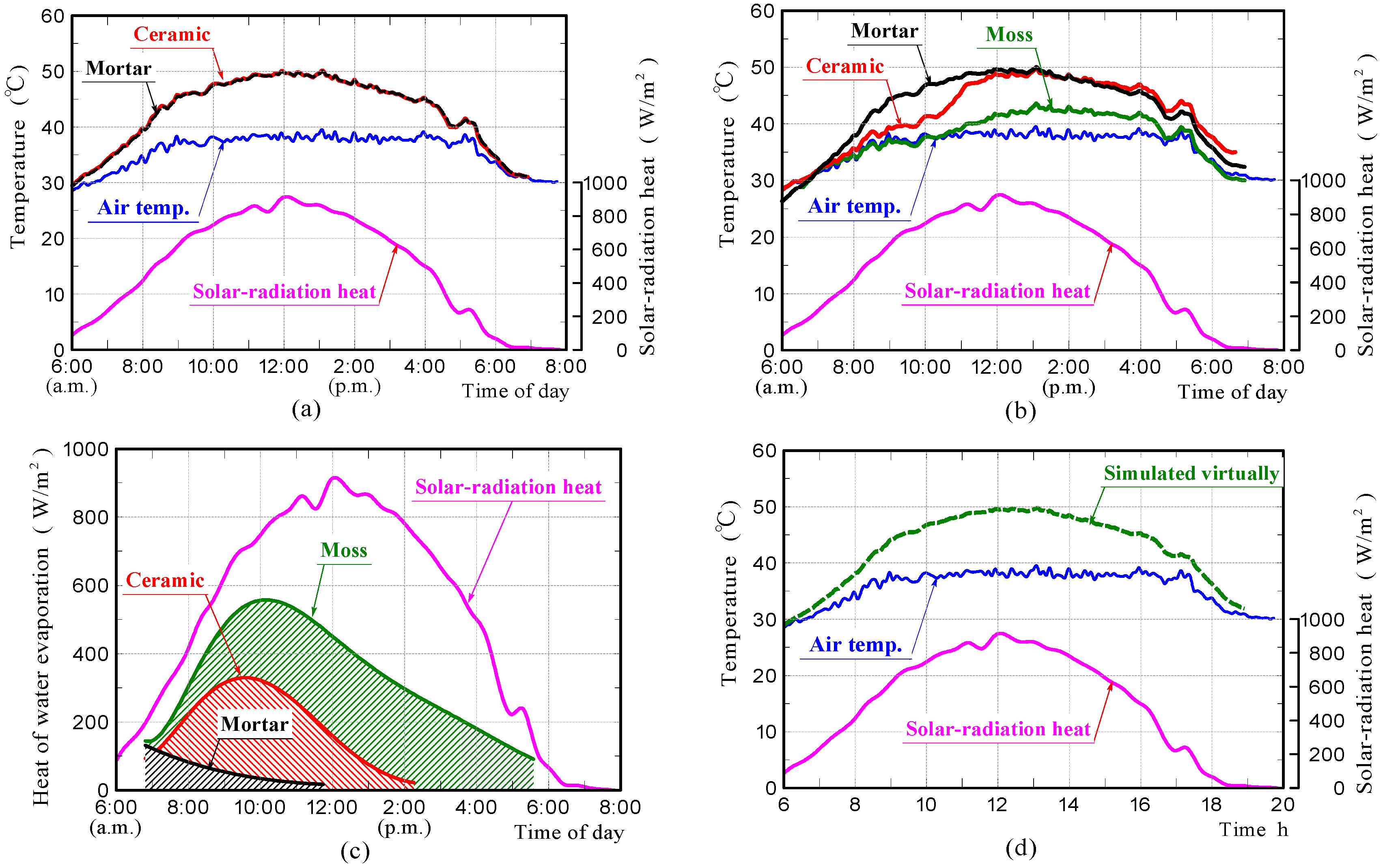
| Component | Clay (Mass %) | Waste Silica (Mass %) |
|---|---|---|
| SiO2 | 64.3 | 93.7 |
| Al2O3 | 23.0 | 5.57 |
| Fe2O3 | 5.75 | 0.14 |
| K2O | 3.94 | <0.1 |
| MgO | 1.63 | <0.1 |
| CaO | 0.26 | <0.1 |
| TiO2 | 0.90 | <0.1 |
| SO3 | 0.12 | 0.54 |
| others | <0.1 | <0.1 |
| Parameters | Mortar | Ceramic | Insulator | |
|---|---|---|---|---|
| Density (kg·m−3) | 2238 | 1800 | 30 | |
| Specific heat (J·kg−1·K−1) | 900 | 620 | 1000 | |
| Thermal conductivity (W·m−1·K−1) | 0.86 | 0.38 | 0.03 | |
| Solar radiation (W·m−2) | measured values | |||
| Air temperature (K) | measured values | |||
| Thermal emissivity | 0.9 | |||
| Coefficient of heat transfer between a sample and air (W·m−2·K−1) | Laboratory experiment | Field experiment | ||
| 18 | 70 | |||
© 2018 by the authors. Licensee MDPI, Basel, Switzerland. This article is an open access article distributed under the terms and conditions of the Creative Commons Attribution (CC BY) license (http://creativecommons.org/licenses/by/4.0/).
Share and Cite
Yasui, K.; Tanaka, A.; Ito, K.; Fujisaki, M.; Kinoshita, H. Experimental and Numerical Analyses of Temperature-Reducing-Effect by Heat of Water Evaporation on a Moss-Greening Ceramic Utilizing Waste Silica. Materials 2018, 11, 1548. https://doi.org/10.3390/ma11091548
Yasui K, Tanaka A, Ito K, Fujisaki M, Kinoshita H. Experimental and Numerical Analyses of Temperature-Reducing-Effect by Heat of Water Evaporation on a Moss-Greening Ceramic Utilizing Waste Silica. Materials. 2018; 11(9):1548. https://doi.org/10.3390/ma11091548
Chicago/Turabian StyleYasui, Kentaro, Ayako Tanaka, Kenichi Ito, Minoru Fujisaki, and Hiroyuki Kinoshita. 2018. "Experimental and Numerical Analyses of Temperature-Reducing-Effect by Heat of Water Evaporation on a Moss-Greening Ceramic Utilizing Waste Silica" Materials 11, no. 9: 1548. https://doi.org/10.3390/ma11091548
APA StyleYasui, K., Tanaka, A., Ito, K., Fujisaki, M., & Kinoshita, H. (2018). Experimental and Numerical Analyses of Temperature-Reducing-Effect by Heat of Water Evaporation on a Moss-Greening Ceramic Utilizing Waste Silica. Materials, 11(9), 1548. https://doi.org/10.3390/ma11091548





